The first modern Dutch cruisers
The Tromp class of the Royal Netherlands Navy (design Argonaut 600) were “flotilla leaders”, conceived as backbones of a squadron of modern destroyers built alongside. Ordered in 1935 they were launched in 1937 and 1939, completed just as the war broke out, the second on 10 May 1940, just as the invasion of the west started.
HrMs Tromp only had time to sail to safety to the Dutch East Indies. Her sister-ship was still fitting out at Den Helder but escaped to the United Kingdom. There she was completely rearmed and served with other Free Dutch ships in the Royal Navy, being sent in the Far East at the end of the war. Amazingly both survived the war, decommissioned in 1955 and 1969, respectively.
Genesis of the design
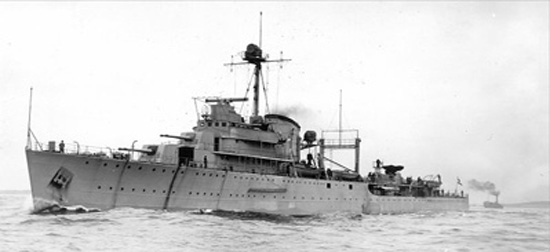
HrMs Tromp in 1938
At the end of the 19th century, Japan developed rapidly and this caused some concerns for the Dutch East Indies governor, about the Japanese Empire expansionism. In 1902, conviction grew that Japan could risk an attack on the Dutch colony, the question was when. Japan and Great Britain just concluded a cooperation treaty, and the RN moved to the North Sea, leaving the Dutch with no allies.
In 1913, the Dutch colony government esteemed that nine battleships were needed to defend it against the Japanese, but WWI disrupted these scheme, followed by an acute economic crisis. Add to this, a strong pacifist movement made suspicious for the Dutch population any grand naval plan and any fleet expansion.
However after 1920, the House of Representatives admitted Japanese militarism and aggressive in Asia needed urgent countermeasures. In May 1920, the budget was increased radically, notably unlocking the construction of two Java class cruisers while a special committee worked on the design of a fleet capable of defending the Dutch East Indies, issuing a 1922 report for a construction programme aimed at 1928.
It notably urged the procurement of 4 cruisers and 24 destroyers plus 32 submarines, and a fleet of auxiliaries and aviation plus the strengthening of naval bases, fortifications and air bases.
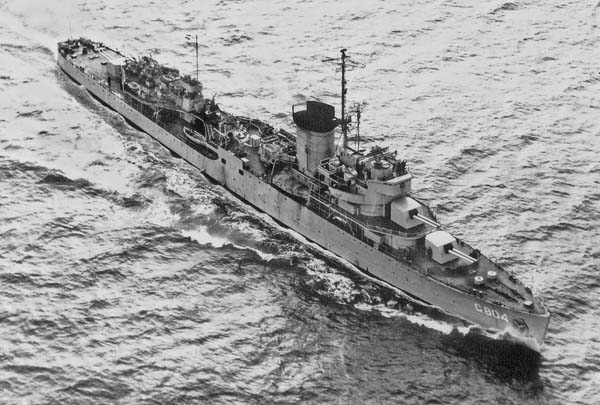
Tromp in 1951 – Fotoafdrukken Koninklijke Marine Coll.
The governor-general of the Dutch East Indies embraced the plan, but it was still blocked by the House of Representatives, due to economic issues and strong pacifism, and this persisted even in 1923, when the plan was halved. Eventually strong lobbying made a vote 49 vs 50 times (against) due to an absent Parliament member. It was submitted again in the early 1930s, and rejected for the same reasons. However by the late 1930s, the Dutch government realized the situation needed to implement the plan in a hurry, and the two cruisers specified became those of the future Tromp class. It also implied on the long run, new gunboats and the Seven Province class cruisers, light cruiser De Ruyter, 1047 battlecruisers.

Tromp plans, as reconstructed from the original blueprints – Fotoafdrukken Koninklijke Marine Coll.
Initially, both cruisers were planned as large destroyers, as destroyers squadron leaders. Their armament was quite massive, but they were classed as light cruisers due to their low tonnage. Both were designed for service in tropical waters, and much attention was paid to ventilation, extraction systems and many portholes, electric refrigerators and drinking water coolers and other fittings in the accommodations to reduced heat fatigue of the crew.
General characteristics
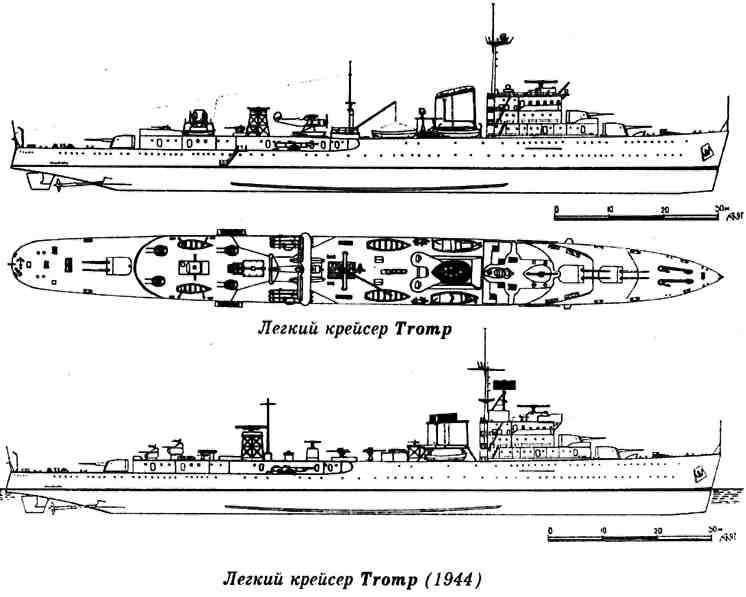
Tromp 1938 and 1944
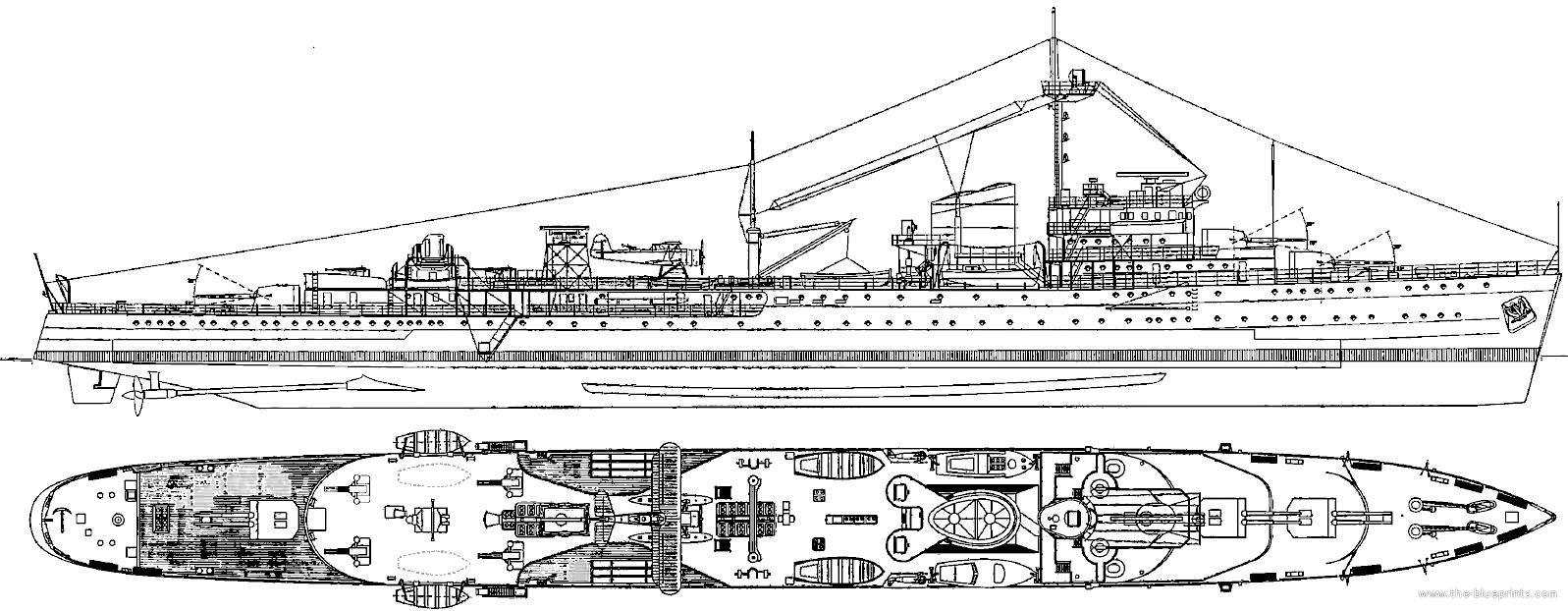
Tromp 1938 general appearance HD
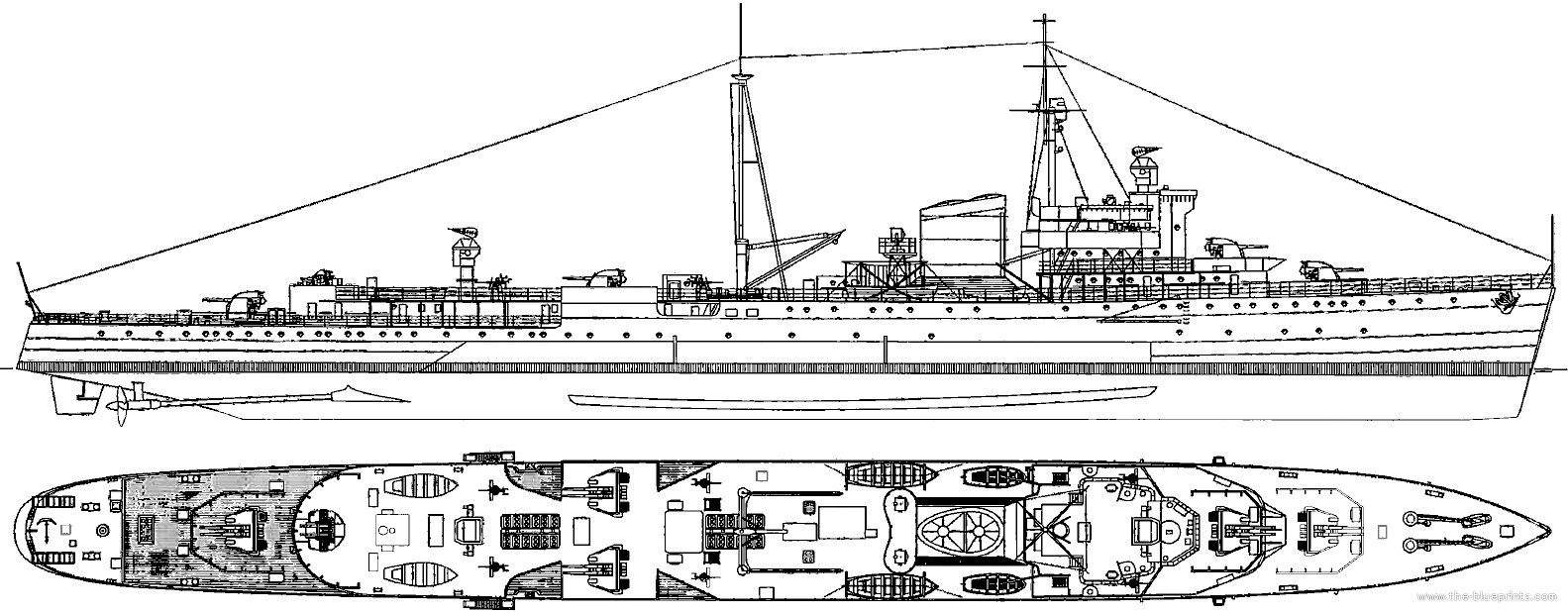
Hrms Jacob Van Heemskerck 1942
By their general appearance, both cruisers looked like a bit like large destroyers, with a long forecastle, a bridge with superfiring artillery and strong torpedo armament. The hull was designed was to displaced 3,350 long tons (3,404 t) standard for 131.95 m (432 ft 11 in) in length, 12.43 m (40 ft 9 in) in beam and a draft of 4.32 m (14 ft 2 in). It was still small, even for a light cruiser (the Washington standard was rather 5000 tonnes), but despite of this, aviation was carried onboard, which greatly extended reconnaissance and artillery spotting capabilities. The crew varied, 380 on HrMs Tromp as completed and 420 on Jacob van Heemskerk during the war.
Propulsion
The powerplant was modern, comprising of course two Parsons geared steam turbines, fed by four Yarrow boilers, driving two shaft propellers. Total output was 56,000 shp (41,759 kW) and top speed 32.5 knots (37.4 mph; 60.2 km/h), sufficient to lead destroyers. Due to her weak length/width ratio of less than 1:10 the cruisers were nimble and fast, but not very agile.
On trials, Tromp achieved a speed of 35.1 knots under calm sea conditions, over a total output of 45,672 kW, which was a rather good performance for a cruiser, far better at any rate than the 1920s Java class.
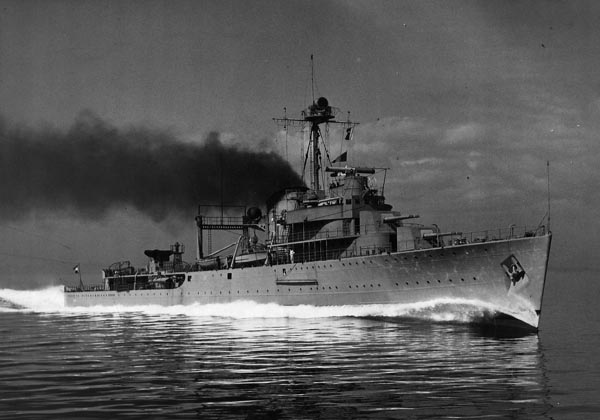
Tromp making her sea trials in 1938
Protection
It was the “poor parent” of the design, naturally lowered to achieve the best speed possible. The Belt was protected by 15 mm (0.6 in), the protective deck received 20 mm armored plates (0.8 in), the conning tower had walls 25 mm (1 in) thick and a stray of the same thickness protected the vital ammunition magazines.
Armament
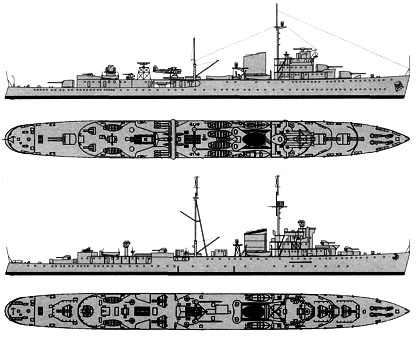
2-views montage showing Tromp and Jacob van Hermseerck as completed, the first as intended, the second as a British standard AA cruiser.
Tromp’s primary armament comprised six 150 mm Bofors guns in three twin-mount (non-armored) small, cramped turrets. The mounts were solidary (no independent elevation). They had 60 degrees elevation for better range and some AA capabilities. Range was 17,500 meters, maximum, not optimum. The secondary armament comprised an AA battery composed of four 75 mm AA guns and four twin 40 mm Bofors anti-aircraft guns located aft on the superstructure roof, with a dedicated fire control. Third, the ship were fitted two triple torpedo tube banks either side after the forecastle. These were standard 21 inches (533 mm) antiship models, of British origin. Tromp was also completed with a Fokker C.XIW floatplane for reconnaissance but no catapult. It was just stored aft of the rear mast on a chariot, and handled by side cranes. Deposed at sea to take-off and retrieve the same way.
Tromp in her 1942 camouflage (AWM)
The case of Heermserck:
Jacob van Heemskerck was caught when fitting out by the German invasion of May 1940. At that stage the fire control for her primary armament was still in Amsterdam, and the ship had to sail in emergency to UK. There, the 150 mm guns were replaced by five British standard twin 102 mm guns dual purpose models, usable against small ships and air targets, and their own fire control. The torpedo tubes were also removed to provide a base for mounting the lateral guns.
Indeed two guns took place in place of the superfiring pair, A and B, and “X” deck position aft, plus the two on side platforms. Therefore the space below was plated-over, making the forecastle extending longer aft. The masts were also modified: A larger tripod mast was fitted aft. Provision was made to mount radars also. These were fitted along with a Huff-Duff when the fore mast was thickened.
The aft twin 40 mm Bofors AA guns were removed but the fire control remained and a single four-barrel 40 mm “Pom-pom” was installed instead and four single 20 mm Oerlikon were placed either side of the aft gunnery control tower, and abreast aft tripod mast. This provided arguably a greater fire density, albeit less accuracy.
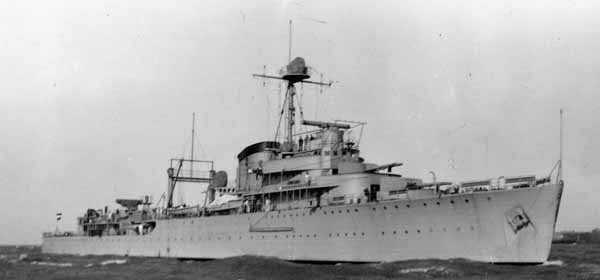
Tromp in service, circa 1939 – Fotoafdrukken Koninklijke Marine Coll.
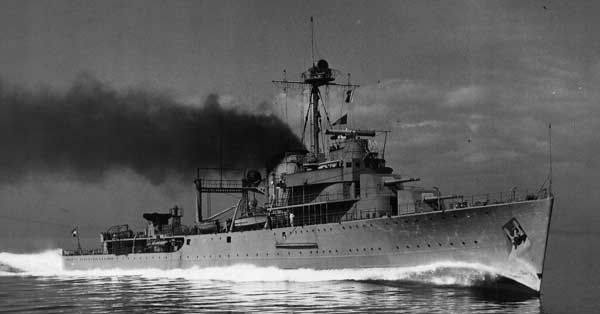
Tromp Launch in trials, 1938 – Fotoafdrukken Koninklijke Marine Coll.
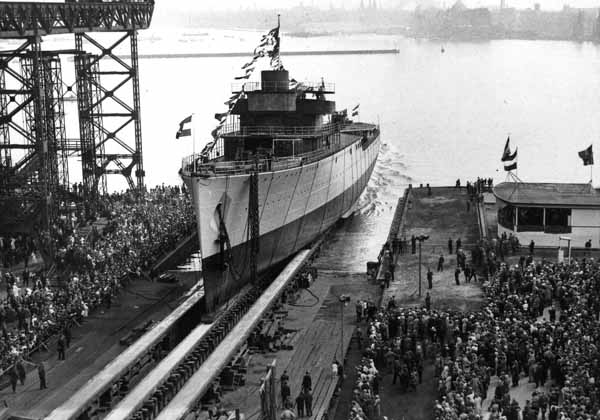
Tromp Launch in 1937 – Fotoafdrukken Koninklijke Marine Coll.
The Tromp class in action
HrMs Tromp

HrMs Tromp in Australia, 1942, with a three Grey tone livery, modeller’s preferred. In 1944 she has like many RN ships a dark blue-grey band, and was in overall grey again in 1946.
By the time she was completed, HrMs Tromp became the most powerful ship of the Dutch Navy, packaging a heavy armament and capabilities in a small package. Until early January 1939 after her trials, and many exercizes, Tromp left Rotterdam for her Mediterranean cruise, stopping at Lisbon on 15 January and colliding with the German liner SS Orinoco. She was back home in April 1939 to participated in the Scheveningen fleet review and made a cruise to Norway, halting at Oslo. In July J. W. Termijtelen took command, replacing Captain L.A.C.M. Doorman and departed for the Netherlands East Indies in August. The war broke out soon after she arrived.
By mid-September she started a serie of search and destroy mission against German merchant ships off Padang and stopped at Surabaya for maintenancet. In 1940 she escorted ships of the Netherlands East Indies Squadron and on the Java to New York Line convoy route, and to the Gilbert Islands (Feb. 1941). Captain J.B. de Meester took command in July 1941 and at the end of the year, a war with Japan was a more and more probable scenario. By November, Tromp looked for Vichy French merchant vessels and until the 7 of December 1941, she patrolled the western Java Sea trying to locate HMAS Sydney, meeting the German raider Kormoran but vanishing without a trace.
After December 7, Tromp joined the Combined Striking Force class ABDA Command. On 18 February 1942, Tromp fought in the battle of Bandung strait. She was badly damaged after being hit by eleven 5-inch (127 mm) shells from the Japanese destroyer IJN Asashio. She hit hit two Japanese destroyers in return but successfully evaded and sailed to Australia for repairs. They took place in February 1942 after a stop at Fremantle. From a drydock in Sydney, she emerged in May 1942.
After short sea trials she joined an ASW patrol force operating off Newcastle. The Soviet steamer Wellen was signalled attacked, but no subamrine was spotted and on 18 May she teamed up with HMAS Arunta to escort the convoy “ZK.8” off Sydney. It was mainly composed of Dutch merchant vessels, Bantam, Bontekoe, Van Heemskerk and Van Heutsz, intended to carry troops and supplies to Port Moresby, the Australian 14th Brigade. Until early June she went on escorting other ships, departing from Sydney or Fremantle, staying there at her return until October 1942, and then Sydney harbor to receive her first modern radar. She departed for New Zealand and back to Australia, escorting a British troopship, SS Nestor.
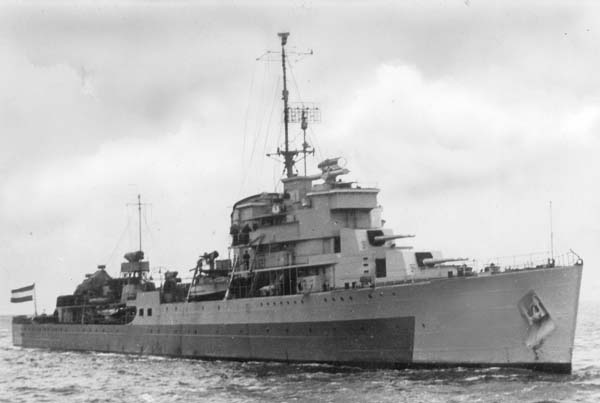
Tromp in the far east, 1945 – Fotoafdrukken Koninklijke Marine Coll.
By February 1943, Tromp was assigned to the US Seventh Fleet, escorting convoys between Australia and the Indian Ocean, and the Dutch cruiser in October saw captain F. Stam taking command. By January 1944 she was dispatched to the British Eastern Fleet in Colombo, Ceylon. She departed to operate next from Trincomalee, participating in the raid on Sabang in April 1944, and the assault on Surabaya in May 1944. In between she escorted more convoys, until sent to Sydney for drydock maintenance. She emeged in February 1945, and sailed to Trincomalee. From there she will make other convoy escort missions, and supported in the final months of WW2 to the invasion by the 7th Division’s of Balikpapan, part of the Borneo campaign.
After the war ended, Tromp joined the British Pacific Fleet and Jakarta, landing marines tasked to disarm the local Japanese garrison. She carried back Dutch OPW between Singapore, Bangkok and Sydney in a few trips and was in Sydney until February 1946. She then departed for hom, carrying 150 former Dutch POW. Soon after arrival in May 1946, she underwent a deep refit and reconstruction lasting until may-june 1948,to serve as a training and accommodation ship. She was stricken in 1955, sold and scrapped in 1969.
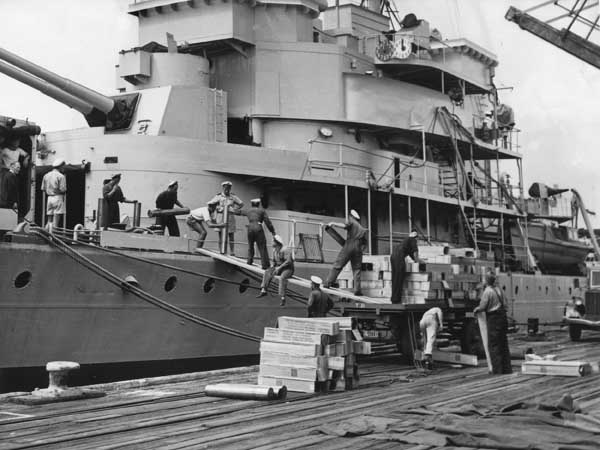
Tromp in Australia, January 1945 – Fotoafdrukken Koninklijke Marine Coll.

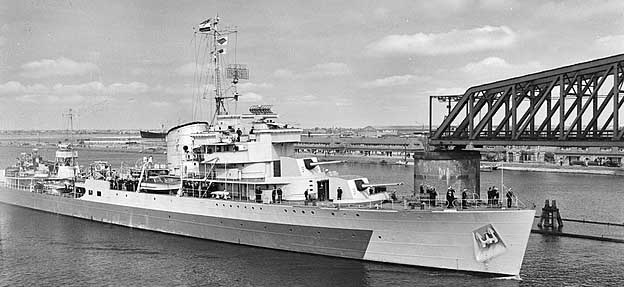
Tromp as rebuilt in 1946
HrMs Jacob Van Heemskerck
Jacob Van Heemskerck was supposed to start her sea trials the same day as the Germans invasion took place, so the admiralty ordered her to sail out and took refuge in UK to prevent her capture. She left without armament with a skeleton crew and the skills of her captain, but fortunately was not attacked by the Luftwaffe en route. She arrived in Portsmouth and was interned. Later, a larger crew was constituted with other Dutch volunteers that fled the occupation, and the Royal Navy decided of her fate. As a recent ship, valuable, it was decided to equip her as an AA cruiser to perform escort duties.
It was decided to fir her with dual purpose 103 mm guns standard for AA cruisers (mostly WW1 era), a quad “pom-pom” and 20 mm Oerlikon guns were added later during the war. But she first received depth charge from the old torpedo boats G13 and G15. On 18 May 1940, Queen Wilhelmina visit the cruiser, which joined HrMs Sumatra to carry Princess Juliana and her family to Canada for safety. She arrived at Halifax on 11 June.
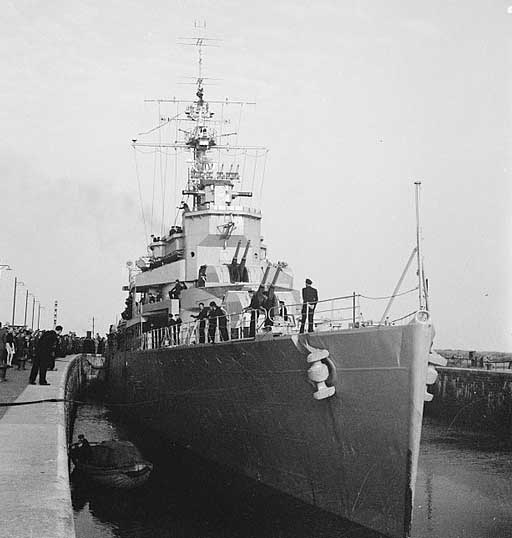
HrMs Jacob Van Heemskerck was back in Portsmouth in July 1940 where she entered the drydock to be armed. Work was completed on 17 February 1941 and she made sea trials, until the end February, departing afterwards for her first convoy escort mission in the Atlantic, affected to the Irish Sea Escort. In January 1942, after many missions, she was sent to the Dutch East Indies, trying to reinforce the composite allied fleet fleet, but she missed the fateful battle of the Java Sea and was reassigned to the Eastern Fleet in instead, in 1942. By September 1942 she was part of operations ‘Stream’ and ‘Jane’, part of the invasion of Madagascar. In October she sailed to Fremantle in Australia and join the Allied Naval Forces Western Australia for more convoy escort.
By November 1942, she sailed with HMAS Adelaide to catch the recently spotted German blockade runner Ramses. When the latter spotted bith cruisers, the captain ordered to be scuttled in the Indian Ocean. In December 1943, Jacob Van Heemskerck joined the Eastern Fleet and then joined the Mediterranean Sea for more convoy duties, until a drydock maintenance in UK in June 1944.
She resumed her convoy escort missions afterwards, until 26 July 1945 when she was present at liberation day in Amsterdam, the first Dutch warship in harbour since the invasion. She would later return to the Dutch East Indies, patrolling until 22 July 1946 and back to the Netherlands with troops in August 1946. She was put in reserved and in March 1951 became a barracks ship for naval cadets at Vlissingen and other harbours. She was eventually decommissioned on 20 November 1969, struck from the lost the next year, and sold for scrap.
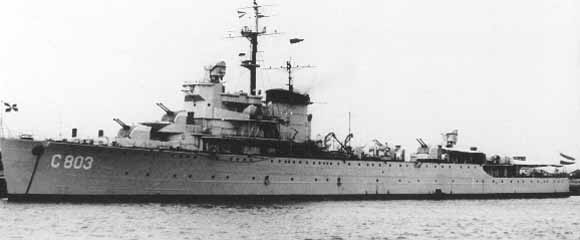
Van Heemskerk in the fear east (circa 1944) – AWM
Read More
Conway’s all the world’s fighting ships 1906-1921 & 1922-1947
https://www.netherlandsnavy.nl/Tromp.htm
https://en.wikipedia.org/wiki/Tromp-class_cruiser
http://www.navypedia.org/ships/netherlands/nl_cr_tromp.htm
Teitler, G. (1984). De strijd om de slagkruisers. Dieren: De Bataafsche Leeuw.
van Dijk, Anthonie (1989). The Drawingboard Battleships for the Royal Netherlands Navy. Part II
//marineschepen.nl/dossiers/waarom-we-de-javazee-niet-moeten-vergeten.html
Grobmeier, Alvin H.; Stroh, Stan; Visser, H. & Wetherhorn, Aryeh “Question 14/00: Characteristics of Dutch Tromp Class Cruisers”. Warship International
Mulder, Jantinus; Mulder, Frits (2012). Destroyer Leader HrMs Tromp.
Kimenai, Peter (May 30, 2011). “Lichte kruisers van de Tromp-klasse”
More photos on the official Royal Netherland Navy site
Models Corner:

-Kombrig 1/700 Tromp 1942
-1/700 Niko Models HrMs Tromp 1942



 Latest Facebook Entry -
Latest Facebook Entry -  X(Tweeter) Naval Encyclopedia's deck archive
X(Tweeter) Naval Encyclopedia's deck archive Instagram (@navalencyc)
Instagram (@navalencyc)





 French Navy
French Navy Royal Navy
Royal Navy Russian Navy
Russian Navy Armada Espanola
Armada Espanola Austrian Navy
Austrian Navy K.u.K. Kriegsmarine
K.u.K. Kriegsmarine Dansk Marine
Dansk Marine Nautiko Hellenon
Nautiko Hellenon Koninklije Marine 1870
Koninklije Marine 1870 Marinha do Brasil
Marinha do Brasil Osmanlı Donanması
Osmanlı Donanması Marina Do Peru
Marina Do Peru Marinha do Portugal
Marinha do Portugal Regia Marina 1870
Regia Marina 1870 Nihhon Kaigun 1870
Nihhon Kaigun 1870 Preußische Marine 1870
Preußische Marine 1870 Russkiy Flot 1870
Russkiy Flot 1870 Svenska marinen
Svenska marinen Søværnet
Søværnet Union Navy
Union Navy Confederate Navy
Confederate Navy Armada de Argentina
Armada de Argentina Imperial Chinese Navy
Imperial Chinese Navy Marinha do Portugal
Marinha do Portugal Mexico
Mexico Kaiserliche Marine
Kaiserliche Marine 1898 US Navy
1898 US Navy Sovietskiy Flot
Sovietskiy Flot Royal Canadian Navy
Royal Canadian Navy Royal Australian Navy
Royal Australian Navy RNZN Fleet
RNZN Fleet Chinese Navy 1937
Chinese Navy 1937 Kriegsmarine
Kriegsmarine Chilean Navy
Chilean Navy Danish Navy
Danish Navy Finnish Navy
Finnish Navy Hellenic Navy
Hellenic Navy Polish Navy
Polish Navy Romanian Navy
Romanian Navy Turkish Navy
Turkish Navy Royal Yugoslav Navy
Royal Yugoslav Navy Royal Thai Navy
Royal Thai Navy Minor Navies
Minor Navies Albania
Albania Austria
Austria Belgium
Belgium Columbia
Columbia Costa Rica
Costa Rica Cuba
Cuba Czechoslovakia
Czechoslovakia Dominican Republic
Dominican Republic Haiti
Haiti Hungary
Hungary Honduras
Honduras Estonia
Estonia Iceland
Iceland Eire
Eire Equador
Equador Iran
Iran Iraq
Iraq Latvia
Latvia Liberia
Liberia Lithuania
Lithuania Mandchukuo
Mandchukuo Morocco
Morocco Nicaragua
Nicaragua Persia
Persia San Salvador
San Salvador Sarawak
Sarawak Uruguay
Uruguay Venezuela
Venezuela Zanzibar
Zanzibar Warsaw Pact Navies
Warsaw Pact Navies Bulgaria
Bulgaria Hungary
Hungary

 Bundesmarine
Bundesmarine Dutch Navy
Dutch Navy Hellenic Navy
Hellenic Navy Marina Militare
Marina Militare Yugoslav Navy
Yugoslav Navy Chinese Navy
Chinese Navy Indian Navy
Indian Navy Indonesian Navy
Indonesian Navy JMSDF
JMSDF North Korean Navy
North Korean Navy Pakistani Navy
Pakistani Navy Philippines Navy
Philippines Navy ROKN
ROKN Rep. of Singapore Navy
Rep. of Singapore Navy Taiwanese Navy
Taiwanese Navy IDF Navy
IDF Navy Saudi Navy
Saudi Navy Royal New Zealand Navy
Royal New Zealand Navy Egyptian Navy
Egyptian Navy South African Navy
South African Navy






























 Ukrainian Navy
Ukrainian Navy dbodesign
dbodesign
It also implied on the long run, new gunboats and the Seven Province class cruisers, light cruiser De Ruyter, 1047 battlecruisers.
1047 battlecruisers : that seems unrealistic !
These were the design 1047 battlecruisers, never built.